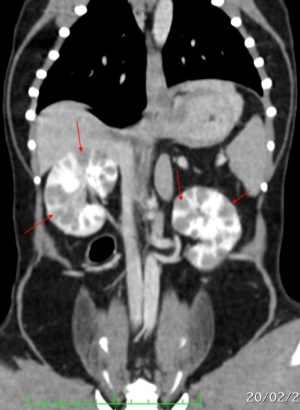
Rare Kidney Cancer
A 12 year old Miniature Schnauzer presented at the referring vet for increased thirst and urination. Other chief complaints were decreased appetite and tremors of both hindlimbs.
Initial diagnostic workup performed by the referring vet revealed a red blood cell count that was markedly increased (polycythemia) and renal parameters that were slightly elevated.
The patient was referred for investigation of polycythemia. He had echocardiography initially which was normal. A whole body contrast CT scan in order to better define the cause of his symptoms and the high red blood cell count. CT showed multiple rounded isoattenuating nodules on both renal cortices that enhance minimally after contrast administration compared with the surrounding cortical tissue (see red arrows below). This was consistent with renal cancer affecting both kidneys. Fine needle aspiration biopsy of the kidneys was performed and the cytology result confirmed renal cancer but it could not further characterize the cancer type. Ultrasound-guided Tru-cut needle biopsy and the use of specific molecular markers (immunohistochemistry) on the samples obtained were necessary to get the final diagnosis of histiocytic sarcoma.
Primary renal tumors are diagnosed uncommonly in dogs. Most such tumors are renal tubular cell carcinomas, transitional cell carcinomas or transitional cell papillomas. Renal tubular cell carcinomas and lymphoma are often bilateral. Histiocytic sarcoma is a rare malignant tumor of the kidney, is bilateral in this case and frequently spreads rapidly. He improved initially on chemotherapy but sadly deteriorated and was put to sleep 6 weeks after the diagnosis.
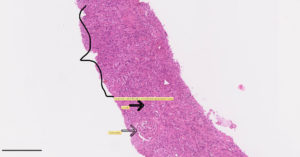
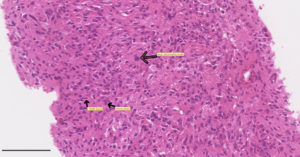
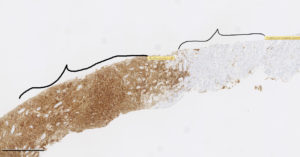
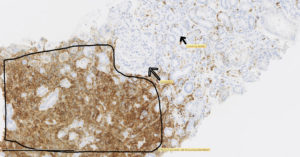
Author
